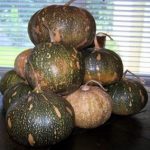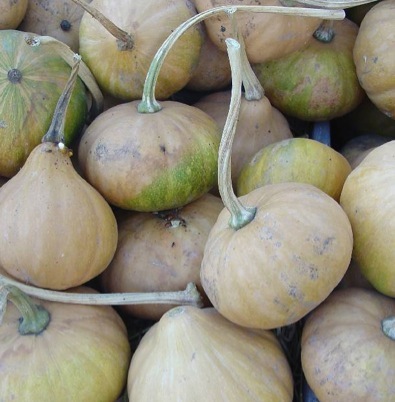Cucurbita muschata: Seminole Pumpkin
Unlike watermelons which are from Africa, pumpkins and their kin are North American natives. When Panfilo de Narvaez was on an expedition in 1528 near what is now Tallahassee, Fl., he saw Seminole Pumpkins under cultivation. They still grow in the wild in many states, Florida north to Pennsylvania. They might have even been in Massachusetts when the Pilgrims arrived.
Let me quote Dr. Julia Morton, the larger-than-life grand dame of edible and poisonous plants in the southeastern US:
“A mainstay of Florida Indians and early settlers, the Seminole pumpkin is botanically identified as a form of Cucurbita moschata Poir., the species embracing the Cushaw or winter Crookneck squashes. It will spread over the ground, drape a fence or climb trees; needs to be fertilized only at planting time; requires no protection from insects. The fruit, variable in form and size, is hard-shelled when mature and keeps at room temperature for months, is excellent baked, steamed or made into pie. The Indians sliced, sun-dried and stored surplus pumpkins. Very young, tender fruits are delicious boiled and mashed; the male flowers excellent dipped in batter and fried as fritters. Thus, the vine produces three totally different vegetables. This is an ideal crop for the home gardener. The portion of the vine which has borne will die back but vigorous runners, which root at the nodes, will keep on growing, flowering and fruiting, yielding a continuous supply.”
The Indians not only cleared land for agriculture but they took advantage of the Seminole Pumpkin, which is a vigorous climber. They would plant it as the base of a dead oak tree and let the vine climb the tree and fruit off the ground. The plant would then grow all over the hammock reseeding itself. The natives were, actually, more ingenious than that. A hammock is a hardwood island in a swampy area. They would girdle the trees on the inner part of the island killing them but turning the inner part into a small field protected by a wind break and prying eyes. Getting the pumpkins down was no issue with a lot of young braves wanting to prove themselves. Uninjured, a Seminole Pumpkin will store for several months even in hot weather if it has good ventilation.
The pumpkin is round, lightly ribbed, around three pounds with tan skin or mottled and green. The sweet flesh is deep orange and dry. Highly productive, it is resistant to insects and disease. The fruit is actually more closely related to butternut and calabaza than the common Halloween pumpkin.
The botanical name, Cucubita moschata (kew-KUR-bi-ta MOSS-kuh-tuh) means Musk-scented Bottle Gourd. Moschata is also where we get the word “musk” from. Cucubita was what the Romans called the bottle gourd.
Green Deane’s “Itemized” Plant Profile

Green Seminole Pumpkins
IDENTIFICATION: Vine, soft-hairy, creeping, leaves ovate or nearly round or sometimes triangularly lobed, toothed, six inches to a foot long, soft, limp. Flowers funnel-shaped, crinkly, yellow, five lobes, three to four inches wide. Fruit comes in many forms, round, oblate, pear-shaped, short-necked, ribbed, orange when ripe with orange-yellow flesh, central cavity more or less filled with soft, fibrous pulp and flat, elliptic, white seeds, to three quarters of an inch long.
TIME OF YEAR: Fall and winter
ENVIRONMENT: Hammocks, everglades, abandoned camps
METHOD OF PREPARATION: Numerous: Boiled or baked, used as a vegetable, dried and ground into a flour for bread, young shoots and leaves cooked as greens, flowers with pistils removed cooked and eaten. They can also be stuffed. Seeds edible, can be roasted or hulled and ground into a gruel.


